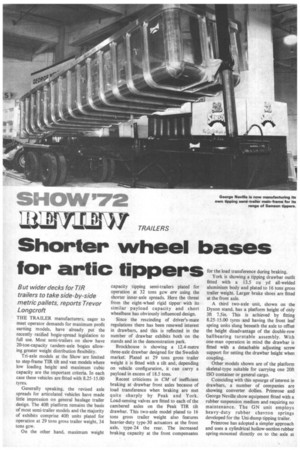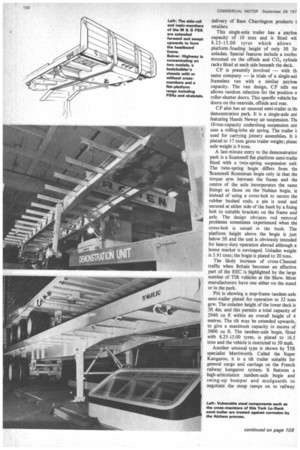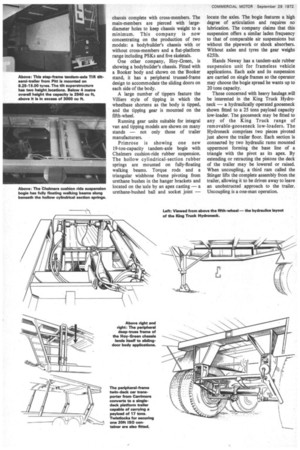Shorter wheel bases for artic tippers
Page 380

Page 381

Page 382

Page 391

Page 392

If you've noticed an error in this article please click here to report it so we can fix it.
But wider decks for TIR trailers to take side-by-side metric pallets, reports Trevor Longcroft
THE TRAILER manufacturers, eager to meet operator demands for maximum profit earning models, have already put the recently ratified bogie-spread legislation to full use. Most semi-trailers on show have 20-ton-capacity tandem-axle bogies allowing greater weight distribution flexibility.
Tr-axle models at the Show are limited to step-frame TIR tilt and van models where low loading height and maximum cubic capacity are the important criteria. In each case these vehicles are fitted with 8.25-15.00 tyres.
Generally speaking, the revised axle spreads for articulated vehicles have made little impression on general haulage trailer design. The 40ft platform remains the basis of most semi-trailer models and the majority of exhibits comprise 40ft units plated for operation at 29 tons gross trailer weight, 34 tons gcw.
On the other hand, maximum weight capacity tipping semi-trailers plated for operation at 32 tons gcw are using the shorter inner-axle spreads. Here the threat from the eight-wheel rigid tipper with its similar payload capacity and short wheelbase has obviously influenced design.
Since the rescinding of driver's-mate regulations there has been renewed interest in drawbars, and this is reflected in the number of drawbar exhibits both on the stands and in the demonstration park.
Brockhouse is showing a 12.4-metre three-axle drawbar designed for the Swedish market. Plated at 29 tons gross trailer weight it is fitted with a tilt and, depending on vehicle configuration, it can carry a payload in excess of 18.5 tons.
Recent criticisms in CM of inefficient braking at drawbar front axles because of load transference when braking are met quite sharply by Peak and York. Load-sensing valves are fitted to each of the cambered axles on the Peak TIR tilt drawbar. This two-axle model plated to 16 tons gross trailer weight also features heavier-duty type-30 actuators at the front axle, type-24 the rear. The increased braking capacity at the front compensates for the load transference during braking.
York is showing a tipping drawbar outfit fitted with a 13.5 cu yd all-welded aluminium body and plated to 16 tons gross trailer weight. Larger brake shoes are fitted at the front axle.
A third two-axle unit, shown on the Dyson stand, has a platform height of only 3ft 7.5 in. This is achieved by fitting 8.25-15.00 tyres and having the front leaf spring units slung beneath the axle to offset the height disadvantage of the double-row ballbearing turntable assembly. With one-man operation in mind the drawbar is fitted with a detachable adjusting screw support for setting the drawbar height when coupling.
Other models shown are of the platform skeletal-type suitable for carrying one 20ft ISO container or general cargo.
Coinciding with this upsurge of interest in drawbars, a number of companies are showing converter dollies. Primrose and George Neville show equipment fitted with a rubber suspension medium and requiring no maintenance. The GN unit employs heavy-duty rubber chevron springs developed for the Uni-dump tipping trailer.
Primrose has adopted a simpler approach and uses a cylindrical hollow-section rubber spring-mounted directly on to the axle at each wheel. The axle is located by radius rods and a wishbone frame assembly which pivots from the dolly hanger brackets and has its apex in the form of a ball-and-socket joint at the axle centre.
There are no automatic coupling dollies at Earls Court, but I would not be surprised if one of the larger companies were to produce one soon.
Strangely, there are no pure skeletals on view. However, most companies are showing maximum-weight-capacity platform skeletals suitable for carrying either two 20ft, one 30ft or one 40ft ISO container.
An unusual side-rave design is a feature of the 361t platform skeletal shown by M & G. The rave comprises two angle-iron sections bolted back-to-back, leaving a flush common side as a rubbing rail. The uppermost rail serves as a chock and in the event of any damage, for instance while loading, it is simply unbolted and replaced. The upper rail is cut away at the twistlock positions.
The lower flange of the main-members and the side rail are extended forward and swept upward to form a frame for the headboard. Another useful feature I have not seen before and which does not apply only to the Tasker Formula 8 platform skeletal it was fitted to, is a cargo lashing ring. A section of the deck directly above the crossmember /side-rave joint has been removed and a large ring in the shape of a chain link is hung around the cross-member completely encircling it. The link is located along the cross-member by a steel plate welded to the member which also serves to secure decking material. The link is free to move vertically and may be used to secure lashing ropes either from below or above the deck.
The sole new platform trailer model exhibited is the York Lo-Deck. This has a solid-section I-beam mainframe instead of the familiar castellated Yolloy type. The mainframe is shallower than previous designs and enables TIP. versions of the Lo-Deck and container-carrying models to comply with the European 4-metre overall height restriction when fitted with standard tyres and operated at normal fifth-wheel coupling heights. A feature — so far as I know unique to York — is the treatment of more vulnerable steel components, notably the I-section cross-members, with the Alchem rustproofing process. The main-members are not similarly treated; instead they are shot-blasted and treated with anti-corrosive primer.
An example of liaison between
manufacturer and customer is the inter-urban trailer, designed by Crane Fruehauf working with Bass Charrington, to produce a tailor-made vehicle suitable for specific applications — in this case the delivery of Bass Charrington products t retailers.
This single-axle trailer has a payloa capacity of 10 tons and is fitted wit 8.25-15.00 tyres which allows platfolin /loading height of only 3ft 3ir unladen. Special features include a toolbo. mounted on the offside and CO2 cylinde racks fitted at each side beneath the deck.
CF is presently involved — with th same company — in trials of a single-axt frameless van with a similar payloac capacity. The van design, CF tells me allows random selection for the -position o roller-shutter doors. This specific vehicle ha doors on the nearside, offside and rear.
CF also has an unusual semi-trailer in flu demonstration park. It is a single-axle uni featuring Hands Neway air suspension. Thi 10-ton-capacity underslung suspension unii uses a rolling-lobe air spring. The trailer h used for carrying joinery assemblies. It i; plated to 17 tons gross trailer weight; plata axle weight is 9 tons.
A last-minute entry to the demonstratior park is a Scamrnell flat-platform semi-trailet fitted with a twin-spring suspension unit. The twin-spring bogie differs from the Scammell Routeman bogie only in that the torque arm between the frame and the centre of the axle incorporates the same fixings as those on the Nubian bogie, ie instead of using a cross-bolt to secure the rubber bushed ends, a pin is used and secured at either side of the bush by a fixing bolt to suitable brackets on the frame and axle. The design obviates rod removal problems sometimes experienced when the cross-bolt is seized in the bush. The platform height above the bogie is just below 5ft and the unit is obviously intended for heavy-duty operation abroad although a home market is envisaged. Unladen weight is 5.91 tons; the bogie is plated to 20 tons.
The likely increase of cross-Channel traffic when Britain becomes an effective part of the EEC is highlighted by the large number of TIR vehicles at the 'Show. Most manufacturers have one either on the stand or in the park.
Pitt is showing a step-frame tandem-axle semi-trailer plated for operation to 32 tons gcw. The unladen height of the lower deck is 3ft 4in. and this permits a total capacity of 2940 cu ft within an overall height of 4 metres. The tilt may be extended upwards, to give a maximum capacity in excess of 3000 cu ft. The tandem-axle bogie, fitted with 8.25-15.00 tyres, is plated to 16.5 tons and the vehicle is restricted to 50 mph.
Another unusual type is shown by TIR specialist Merriworth. Called the Super Kangaroo, it is a tilt trailer suitable for general cargo and carriage on the French railway kangaroo system. It features a high-articulation tandem-axle .bogie and swing-up bumper and mudguards to negotiate the steep ramps on to railway wagons. The trailer has the usual spherical coupling at the front to which the French shunt tractors couple for roll-on loading; it also has bolster points for crane lifting on to railway wagons.
Peak has a step-frame, tilt-covered semi-trailer in the demonstration park which has its mainframe cut away and flitched .above the tandem-axle bogie. The lower flange line of the mainframe falls beneath bogie axle height, offering a degree of axle protection.
Common-size side-rails and roof-rails on the Crane Fruehauf TIR semi-trailer tilt superstructure allow the side rails to fit anywhere along the side, and roof rails anywhere along the roof. The dropsides feature Pescalock spring-loaded locks, and the complete outfit is claimed to be £400 cheaper than comparable outfits.
Integral vans and bodied semi-trailers have big futures. Such vans offer operators a saving in the initial cost, and the replacement and up-keep of tarpaulins, fly sheets and ropes.
Only one new model van is displayed, by York, although many other companies are showing units, most recently modified to accept side-by-side stacking of metric pallets, ie the internal width is increased beyond 2.4 metres — another European influence on trailer design.
The York outfit is a tri-axle semi-drop-platform Freightmaster van, with an internal width in excess of 2.4 metres. As with most step-frame designs 8.25-15.00 tyres are used; an additional feature is a load-sensing valve fitted over the two rearmost axles.
Peak has a tandem-axle van for dry freight in the demonstration park. Called the Peak Strongbox, it uses identical section panels to that of the Tidd Strongbox body. The side panel is one piece, 4011 by 911 and the internal width again allows the double stacking of metric pallets.
Highway is showing a bodybuilder's chassis complete with cross-members. The main-members are pierced with largediameter holes to keep chassis weight to a minimum. This company is now concentrating on the production of two models: a bodybuilder's chassis with or without cross-members and a fiat-platform range including PSKs and five skeletals.
One other company, Hoy-Green, is showing a bodybuilder's chassis. Fitted with a Booker body and shown on the Booker stand, it has a peripheral trussed-frame design to accommodate the sliding doors on each side of the body.
A large number of tippers feature the Villiers style of tipping in which the wheelbase shortens as the body is tipped, and the tipping gear is mounted on the fifth-wheel.
Running gear units suitable for integral van and tipping models are shown on many stands — not only those of trailer manufacturers.
Primrose is showing one new 19-ton-capacity tandem-axle bogie with Chahners cushion-ride rubber suspension. The hollow cylindrical-section rubber springs are mounted on fully-floating walking beams. Torque rods and a triangular wishbone frame pivoting from urethane bushes in the hanger brackets and located on the 'axle by an apex casting — a urethane-bushed ball and socket joint — locate the axles. The bogie features a high degree of articulation and requires no lubrication. The company claims that this suspension offers a similar laden frequency to that of comparable air suspensions but without the pipework or shock absorbers. Without axles and tyres the gear weighs 6251b.
Hands Neway has a tandem-axle rubber suspension unit for frameless vehicle applications. Each axle and its suspension are carried on single frames so the operator may choose the bogie spread he wants up to 20 tons capacity.
Those concerned with heavy haulage will be interested in the King Truck Hydroneck — a hydraulically operated gooseneck shown fitted to a 25 tons payload capacity low-loader. The gooseneck may be fitted to any of the King Truck range of removable-gooseneck low-loaders. The Hydroneck comprises two pieces pivoted just above the trailer floor. Each section is connected by two hydraulic rams mounted uppermost forming the base line of a triangle with the pivot as its apex. By extending or retracting the pistons the deck of the trailer may be lowered or raised. When uncoupling, a third ram called the Stinger lifts the complete assembly from the trailer, allowing it to be driven away to leave an unobstructed approach to the trailer. Uncoupling is a one-man operation.
































































































































































































































































































































































































































































































































